The detailed organization of the human cerebellum estimated by intrinsic functional connectivity within the individual
- PMID: 33427596
- PMCID: PMC7948146
- DOI: 10.1152/jn.00561.2020
The detailed organization of the human cerebellum estimated by intrinsic functional connectivity within the individual
Abstract
Distinct regions of the cerebellum connect to separate regions of the cerebral cortex forming a complex topography. Although cerebellar organization has been examined in group-averaged data, study of individuals provides an opportunity to discover features that emerge at a higher spatial resolution. Here, functional connectivity MRI was used to examine the cerebellum of two intensively sampled individuals (each scanned 31 times). Connectivity to somatomotor cortex showed the expected crossed laterality and topography of the body maps. A surprising discovery was connectivity to the primary visual cortex along the vermis with evidence for representation of the central field. Within the hemispheres, each individual displayed a hierarchical progression from the inverted anterior lobe somatomotor map through to higher-order association zones. The hierarchy ended at Crus I/II and then progressed in reverse order through to the upright somatomotor map in the posterior lobe. Evidence for a third set of networks was found in the most posterior extent of the cerebellum. Detailed analysis of the higher-order association networks revealed robust representations of two distinct networks linked to the default network, multiple networks linked to cognitive control, as well as a separate representation of a language network. Although idiosyncratic spatial details emerged between subjects, each network could be detected in both individuals, and seed regions placed within the cerebellum recapitulated the full extent of the spatially specific cerebral networks. The observation of multiple networks in juxtaposed regions at the Crus I/II apex confirms the importance of this zone to higher-order cognitive function and reveals new organizational details.NEW & NOTEWORTHY Stable, within-individual maps of cerebellar organization reveal orderly macroscale representations of the cerebral cortex with local juxtaposed zones representing distinct networks. In addition, individuals reveal idiosyncratic organizational features.
Keywords: Bayesian; association cortex; default network.
Conflict of interest statement
No conflicts of interest, financial or otherwise, are declared by the authors.
Figures

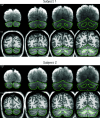




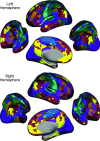
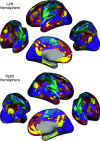

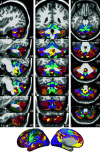


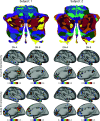
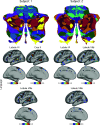

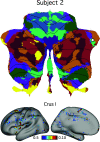
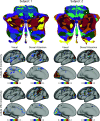
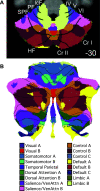
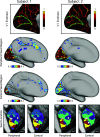
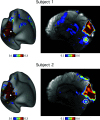

Similar articles
-
The organization of the human cerebellum estimated by intrinsic functional connectivity.J Neurophysiol. 2011 Nov;106(5):2322-45. doi: 10.1152/jn.00339.2011. Epub 2011 Jul 27. J Neurophysiol. 2011. PMID: 21795627 Free PMC article.
-
A third somatomotor representation in the human cerebellum.J Neurophysiol. 2022 Oct 1;128(4):1051-1073. doi: 10.1152/jn.00165.2022. Epub 2022 Sep 21. J Neurophysiol. 2022. PMID: 36130164 Free PMC article.
-
Organization of the human cerebral cortex estimated within individuals: networks, global topography, and function.J Neurophysiol. 2024 Jun 1;131(6):1014-1082. doi: 10.1152/jn.00308.2023. Epub 2024 Mar 15. J Neurophysiol. 2024. PMID: 38489238 Free PMC article.
-
Functional Connectivity of the Cognitive Cerebellum.Front Syst Neurosci. 2021 Apr 8;15:642225. doi: 10.3389/fnsys.2021.642225. eCollection 2021. Front Syst Neurosci. 2021. PMID: 33897382 Free PMC article. Review.
-
Cerebellar pathology in Alzheimer's disease.Hell J Nucl Med. 2019 Jan-Apr;22 Suppl:174-179. Hell J Nucl Med. 2019. PMID: 30877735 Review.
Cited by
-
Cerebello-cerebral resting-state functional connectivity in spinocerebellar ataxia type 3.Hum Brain Mapp. 2023 Feb 15;44(3):927-936. doi: 10.1002/hbm.26113. Epub 2022 Oct 17. Hum Brain Mapp. 2023. PMID: 36250694 Free PMC article.
-
Data on a novel approach examining the role of the cerebellum in gait performance improvement in patients with Parkinson disease receiving neurologic music therapy.Data Brief. 2023 Feb 27;47:109013. doi: 10.1016/j.dib.2023.109013. eCollection 2023 Apr. Data Brief. 2023. PMID: 36936642 Free PMC article.
-
A Functional Atlas of the Cerebellum Based on NeuroSynth Task Coordinates.Cerebellum. 2024 Jun;23(3):993-1012. doi: 10.1007/s12311-023-01596-4. Epub 2023 Aug 22. Cerebellum. 2024. PMID: 37608227 Free PMC article.
-
Cerebellar network organization across the human menstrual cycle.Sci Rep. 2020 Nov 26;10(1):20732. doi: 10.1038/s41598-020-77779-4. Sci Rep. 2020. PMID: 33244032 Free PMC article.
-
Crus control: effective cerebello-cerebral connectivity during social action prediction using dynamic causal modelling.Soc Cogn Affect Neurosci. 2025 Mar 4;20(1):nsaf019. doi: 10.1093/scan/nsaf019. Soc Cogn Affect Neurosci. 2025. PMID: 39953800 Free PMC article.
References
Publication types
MeSH terms
Grants and funding
LinkOut - more resources
Full Text Sources
Other Literature Sources
Miscellaneous

